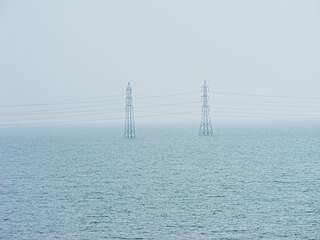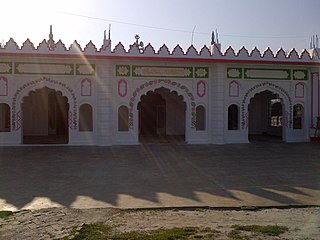
Goramansingh also known as Gauramansingh is a small village in the Darbhanga district of Bihar, India. It is located approximately 62 kilometers east of Darbhanga and 12 kilometers east from its subdivisional headquarters of Biraul on the bank of the Kamala River in Bihar.

Madhepura district is one of the thirty-eight districts of Bihar state, India, and Madhepura town is the administrative headquarters of this district. Madhepura district is a part of Kosi division.
Morsand is a village in Sitamarhi district, Bihar state, India. It is situated 18 km. to the southeast of the town of Sitamarhi on the banks of the river - Lakhandei, and is connected to the district headquarters via National Highway 77 Sitamarhi- Hajipur. The nearest railway stations are Sitamarhi and Muzaffarpur, and the nearest airport is in Patna. Now a new railway station is established in the village itself with the name "Runni Saidpur", which will be providing rail connectivity from this village to the rest of India.

The 2008 Bihar flood was one of the most disastrous floods in the history of Bihar, an impoverished and densely populated state in India. The Koshi embankment near the Indo-Nepal border broke on 18 August 2008. The river changed course and flooded areas which had not been flooded in many decades. The flood affected over 2.3 million people in the northern part of Bihar.
Jajuara, also written Jajuar and Yajuar, is the largest village in the Muzaffarpur district of Bihar in India, and the second-largest village in Bihar.

Kataiya ( ) is a village development committee (VDC) in the central part of Saptari in the Sagarmatha Zone of south-eastern part of Nepal. This VDC is about 5km south of Rupani bazaar, a bazaar through which the East-West Highway passes and about 15km north of Indo-Nepal border. It is about 8km north-west of the headquarter of Saptari district as well as Sagarmatha zone, Rajbiraj. The VDC comprises 9 wards. It lies in Illaka No. 11. On the basis of 2011AD. census, there are 9,554 population living in about 1,500 individuals houses.
Bharaul is a small village situated in Bachhwara tehsil and located in Begusarai district of Bihar. It is one of 91 villages in Bachhwara Block along with villages like Rudauli and Arwa. Bharaul and Aagapur Kothi are on river-side of the Balan River opposite of each other. The nearest railway station from Bharaul is Bachhwara Junction which is 5.5 km away from the village. The main language of Bharaul is Maithili. Hindi is also spoken by most of the settlers. Bharaul village has a higher literacy rate compared to Bihar. In 2011, the literacy rate of Bharaul village was 63.64% compared to 61.80% of Bihar. In Bharaul, male literacy stood at 70.37% while female literacy rate was 56.45%.
Sihaul is a village with population of about 11,000 in the sub-district of Satar Kataiya, where it ranks as the third most populous village. The sub-district forms a part of Saharsa district in the state Bihar, India. The geographical area of the village is 9 km2 (3.5 sq mi) and it is the third biggest village by area in the sub-district. Population density of the village is 1287 persons per km2.
Bangaon is an ancient northern Indian village situated in the Saharsa district of Bihar. Some historians believe that 'Apannigam' referred in Buddhistic literature is Bangaon. Bangaon is part of Kahra Block of the district. Some of the neighbouring places include Bariahi, Bangaon, Chainpur, Mahishi and Bihar (north). Bangaon is divided into three panchayats namely Bangaon North, Bangaon South and Bangaon East.

Kakila is a village in the Jagdishpur thana of Bihar (India). It falls under Bhojpur District, and it is around 30 kilometers from the District Headquarters Arrah. Kakila provides a view of nature as it is surrounded by greenery, ponds and rivers.
Chainpur is one of the largest villages of Saharsa District in the Indian state of Bihar in North-East India, and is in the Kosi Division. In the revenue documents, it is mentioned as 'Chainpur Uttar Khand'. Chainpur has a number of tolas and occasionally called Pubari, Pachhwari, Uttarwari and Dakshinwari tola.
Swarndih, formerly Sondhia, is a small village in the Indian state of Bihar. Swarndih is known to have existed as a village since 1932. In 1950, Swarndih became an important political center. Committees are formed by youths of the village and reviewed periodically when needed.
Dhrubganj is a gram panchayat of Kharik block in Bhagalpur district of Bihar state in India. It comes under the legislative assembly of Bihpur. Before the abolition of Zamindari system in India, this village was considered as a village of Zamindars. However, after the abolition of zamindari, most of the people lost their lands and now are small scale peasants.
Gisara urf Gidhsara is an area in the Sitamarhi district of the state of Bihar, in north-east India. Due to frequent flooding, Gisara has significant alluvial deposits. Because of its geography, the area is rich in agriculture. The main market areas are around Gisara Bazar and Gisara Chauraha.
Manik Chowk is a village in the Indian state of Bihar.

Majhaul is a large Village in Nauhatta Block in Saharsa District of Bihar State of India, with total 700-800 families residing. It belongs to Kosi Division.
GaziPaita 'गाजीपैता' is a village in Sonbarsa Raj, Saharsa District, Bihar state. It belongs to Kosi Division.
Rajdham is a village in Gogari block of Khagaria district of Bihar State, India.
Rupani is a small rural municipality in Saptari District in the Sagarmatha Zone of south-eastern Nepal. At the time of the 2019 Nepal census it had a population of 29,989 people living in about 8500 individual households.

Basuki Bihari is a big village in the Madhubani district in State of Bihar, India. According to India Population Census 2011 the population of the village is 14385. The majority of people of this village speak in Maithili language. The total area of the village is 13.62 km2. The village is divided into two Gram Panchayat Basuki Bihari North and Basuki Bihari South. The head of the Gram Panchayat is called as Mukhiya. Mukhiya is elected by adult people of the village. The election of Mukhiya is held by the Election Commission of Bihar state. This village is known for social cultural activities like Durga Puja, Chhath, Kali Puja and Sarswati Puja. The village is connected by State Highway No 75 from Darbhanga to Madhwapur. This village is only two kilometres far from the Indo-Nepal Border at Madhwapur in Madhubani district.













